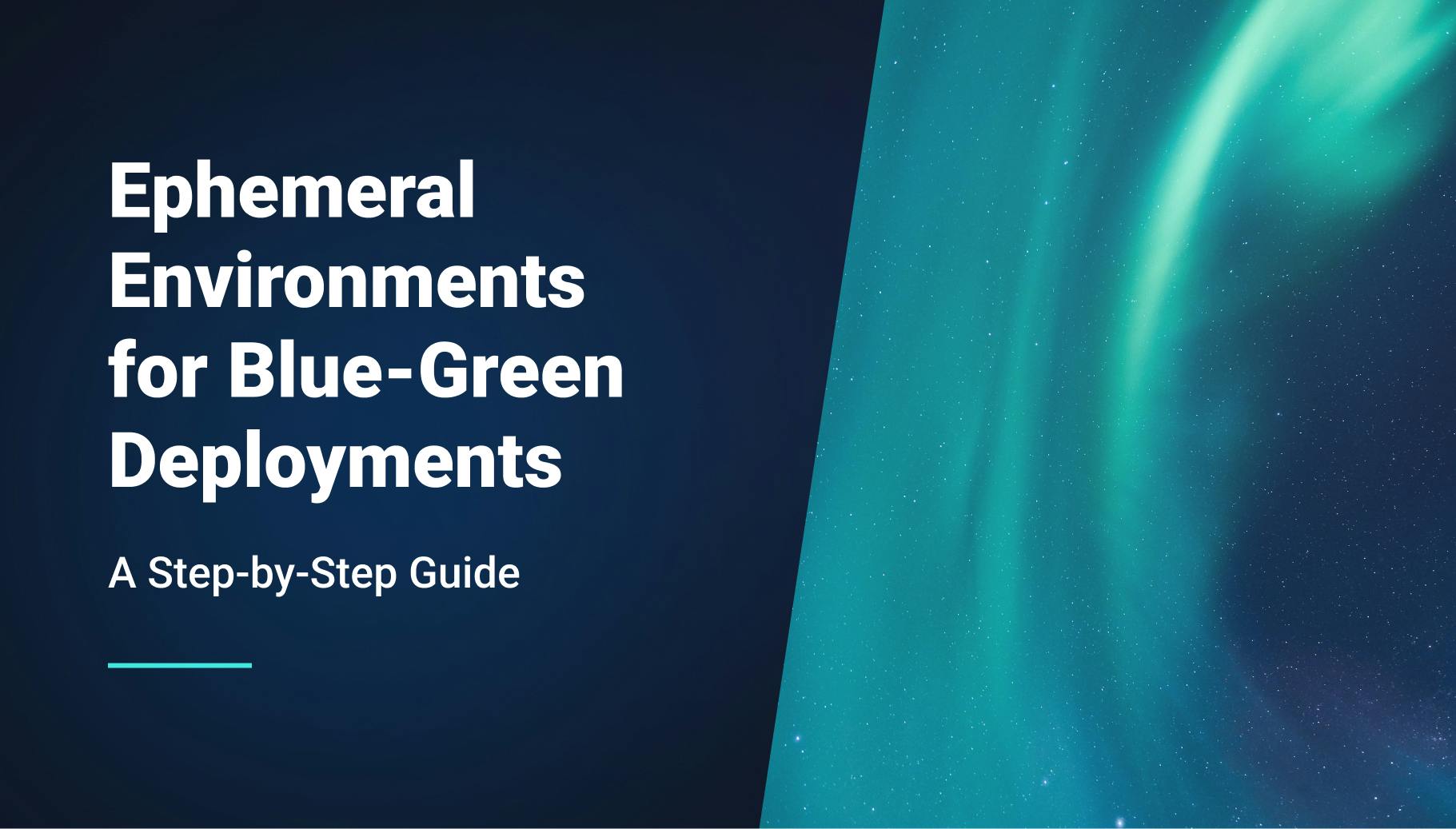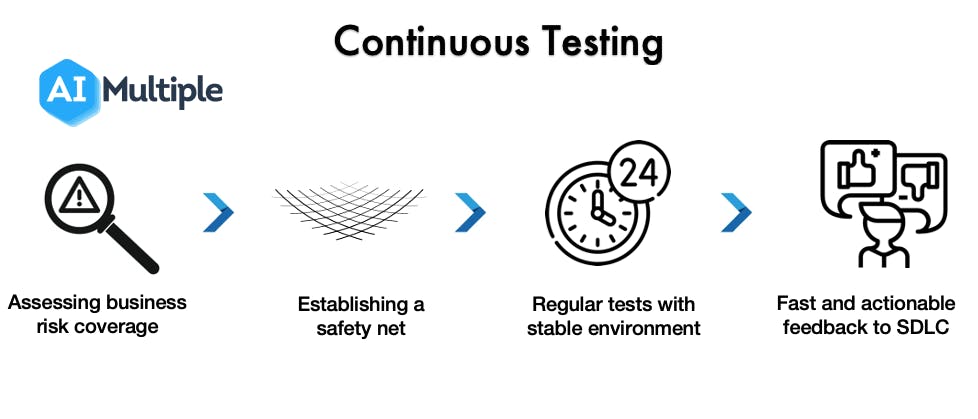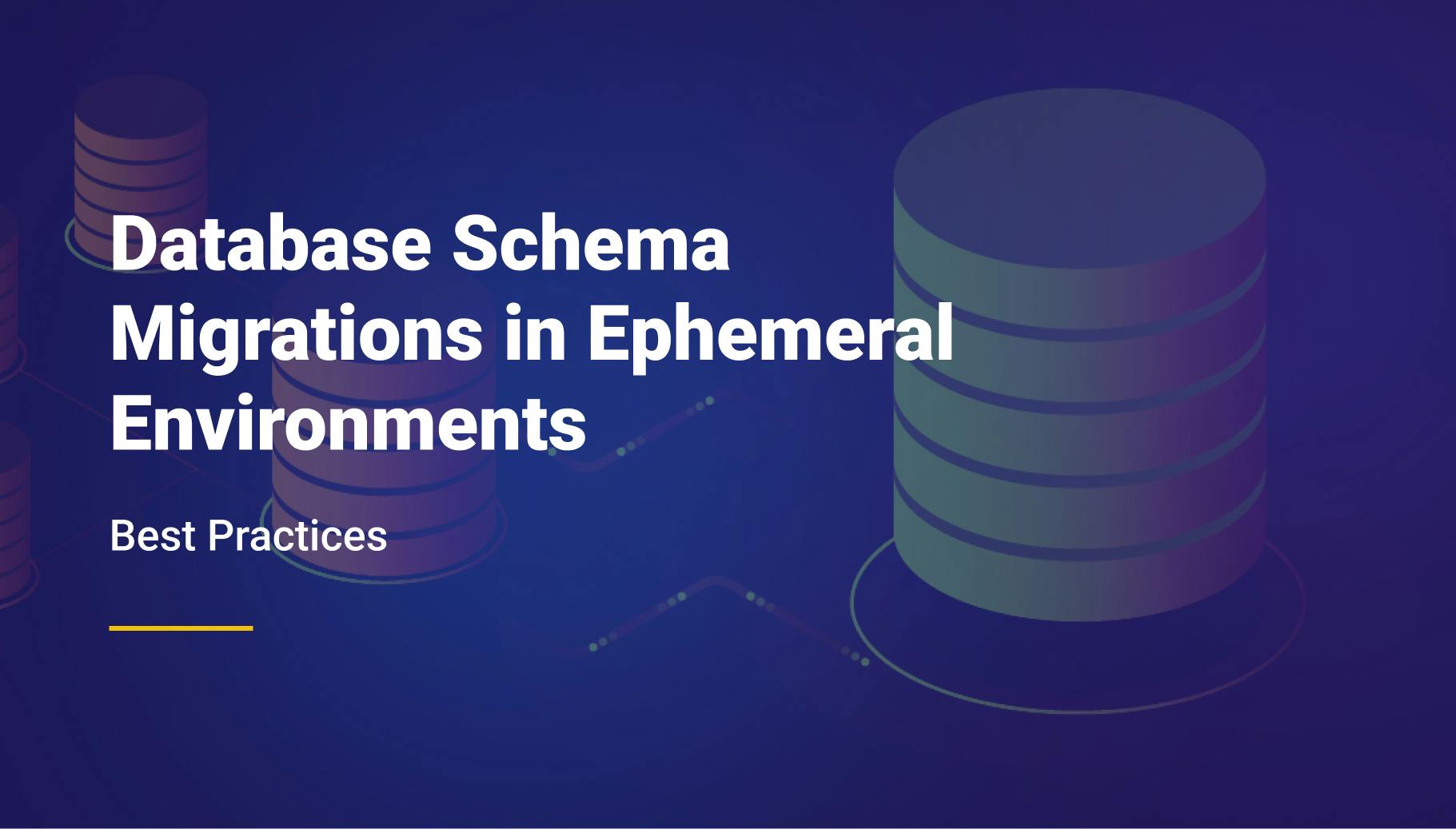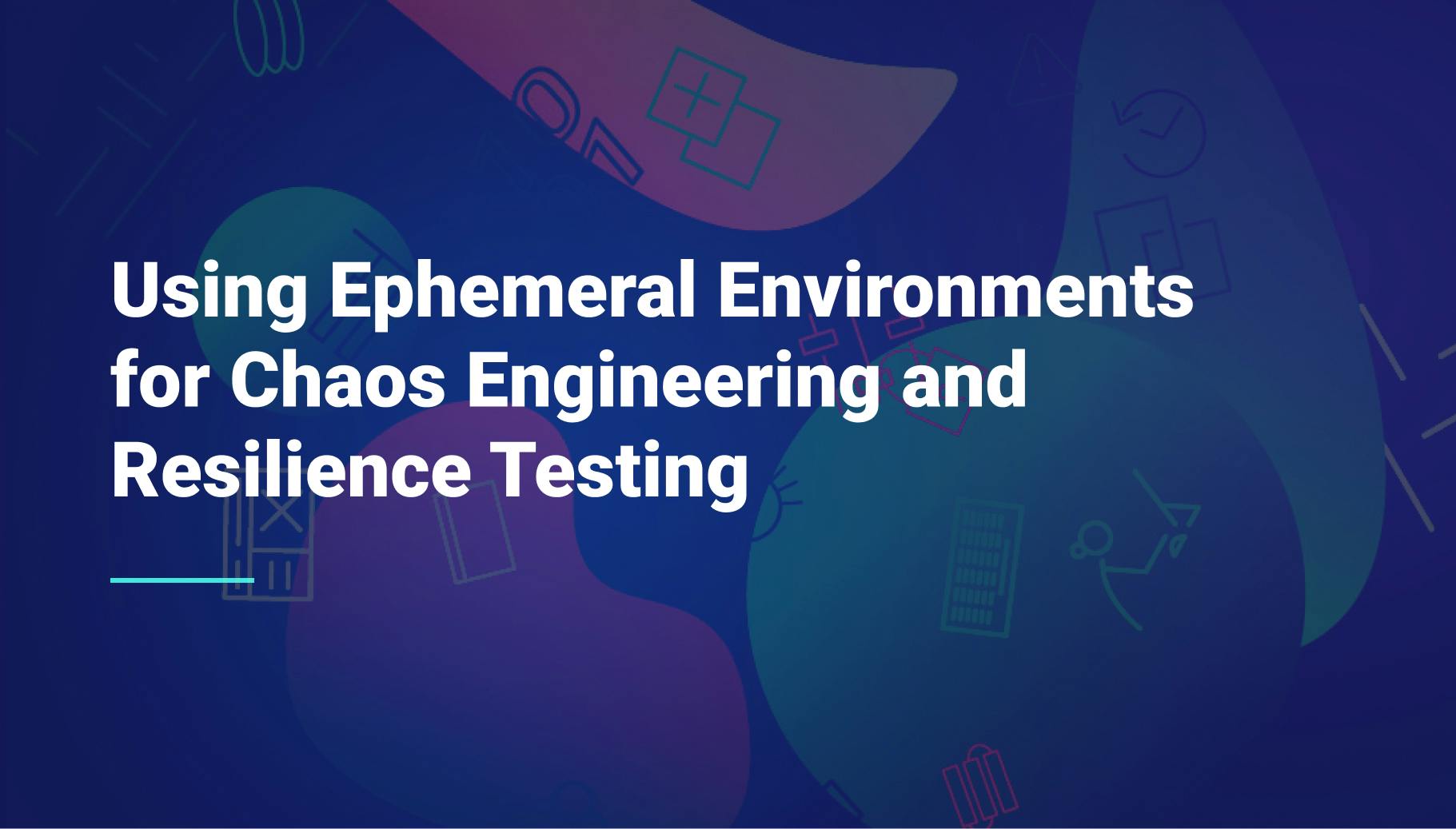Ephemeral Environments for Blue-Green Deployments: A Step-by-Step Guide
Blue-green deployments have emerged as a beacon for seamless updates in software development. By juggling two environments, blue (old) and green (new), changes are tested and rolled out with minimal hiccups. Yet, traditional environments, with their database schemas and code differences, often throw a spanner in the works.
Enter ephemeral environments. Imagine creating a production-like environment, using it just as long as needed, and then discarding it immediately after use. This nifty addition to the blue-green strategy simplifies deployments; you’ll see precisely how in this guide. Dive in for a mix of theory, real-world examples, and actionable steps, all geared to streamline your next deployment. Let's start with the blue-green deployment strategy.

Morgan Perry
September 30, 2023 · 11 min read
#Demystifying Blue-Green Deployments
#What Are Blue-Green Deployments?
Blue-green deployments represent a strategy to minimize downtime and establish a smooth transition during software updates. By leveraging two separate environments – aptly named "blue" and "green" – this approach ensures that one version of the app is always live. While the 'blue' environment might run the current production code, the 'green' environment gets primed with new changes. Once the green environment passes all tests and checks, a simple switch reroutes user traffic to it.
For instance, consider a database schema: in a blue-green deployment, you'd first test changes in the green environment. Once validated, you'd seamlessly switch users to experience this new version, while the blue environment might act as a backup or get updated next.
#Why Using Blue-Green Deployments? Key Benefits
- Risk Mitigation: Instead of direct changes in the production environment, blue-green deployments let developers introduce and verify updates in a separate setting first. This system acts as a safeguard, ensuring that users don't see undercooked features or face downtime.
- Smooth Rollbacks: Let's say you've rolled out a feature, but suddenly something seems amiss. With blue-green, reverting back is a breeze. You just pull users back to the stable blue environment without the complexities of undoing code changes.
- DevOps and CI Integration: Incorporating blue-green methods can help streamline DevOps processes. Continuous Integration (CI) tools can work seamlessly, deploying code to the green environment, running tests, and ensuring everything is ready before the big switch.
#Challenges with Traditional Blue-Green Deployments
While the concept of blue-green deployments might seem enticing, it isn't without its pitfalls, especially in traditional environments. Here are some of its challenges:
- Resource Intensive: Maintaining two environments can be a drain, both in terms of cost and management. You're essentially doubling up on your environments, requiring more data storage, processing power, and upkeep.
- Database Synchronization: As changes occur, synchronizing databases between the two environments can get tricky. For example, if a user creates a new account in the blue environment right before a switch, ensuring that data persists in the green environment can be a challenge. Mention previous article on database migrations with ephemeral environment.
- Consistency Issues: In large development teams, multiple members might work on the same features or sections. Managing and integrating these concurrent changes into a green environment requires careful coordination. If not managed correctly, you could see inconsistencies post-deployment.

#Introduction to Ephemeral Environments
#What are Ephemeral Environments?
In the vast landscape of data and code, imagine ephemeral environments as transient spaces, akin to pop-up shops in the bustling market of development. They emerge, serve a purpose, and gracefully retire. Specifically, within the blue-green deployment realm, they act as the testing grounds for 'blue' before the spotlight shifts to 'green'. When developers need to pull, preview, or test a version of the code momentarily, these environments come to their rescue, only to disappear once their role concludes.
#Traditional vs. Ephemeral Environments
When we speak of environments in development, the traditional ones are our old, steadfast friends. Let's see how:
- Steady vs. Dynamic: Traditional environments maintain their schema, akin to a tree firmly rooted. Ephemeral environments, on the other hand, embrace change, sprouting and wilting with the needs of the moment.
- Continuity vs. Fickleness: While the traditional database persists, showing consistency, the ephemeral one might dance around, shifting its form, and then settling - exemplifying burstiness.
- Care Needs: The old-school environment demands regular care and upkeep. Ephemeral? It's self-cleaning, appearing when summoned and dissolving post service.
#Ephemeral Environments In Blue-Green Deployments: Key Advantages
Harnessing the power of ephemeral environments for blue-green deployments offers a handful of advantages:
- Safety First: Before taking the leap with 'green', the changes get a test run in the ephemeral space, ensuring minimized risks.
- Resource Efficiency: Instead of maintaining a permanent test environment, the create-manage-dissolve rhythm of ephemeral environments is resource-friendly.
- CI/CD Integration: Ephemeral environments are like a secret handshake in the DevOps world, aligning seamlessly with Continuous Integration and Continuous Deployment.
- Swift Feedback Loop: With their transient nature, developers can swiftly see the results of their work, gather feedback, and iterate.
#Benefits of Combining Ephemeral Environments and Blue-Green Deployments
#Enhanced Testing and Development Cycles
- Varied Data Inputs: Ephemeral environments help in mimicking real-world scenarios, providing varied data sets for rigorous testing. This is where the keyword 'data' fits snugly.
Example: Imagine testing a code change in a database schema. With an ephemeral environment, one can see how these changes affect both the existing and new data sets before pushing to production.
- Tailored Development Environments: DevOps teams can create and manage tailored environments that mimic production, making the development-to-production transition smoother.
For Instance: If you're working on version 2.0 of your application, having a short-lived, separate environment that’s an exact replica of your production setting can be invaluable.
- Quick Iterations: Rapid feedback is possible because any code change, be it a small tweak or a significant revamp, can first be tested in an isolated environment.
- Real-world Case: A developer wishes to pull the latest code, make changes, and immediately see the impact. Instead of waiting for the main test environment to be free, they can spin up an ephemeral one.
#Elevated Security and Resource Utilization
- Dynamic Resource Management: Ephemeral environments only exist when they're needed, optimizing resource utilization. When the work is done, they vanish, ensuring you don't waste resources on stagnant test environments.
- Data Protection: Since these environments are temporary, sensitive data is less exposed. It’s a smart move for those extra-cautious about security.
- Consistency Across Environments: The ephemeral nature ensures environments are always fresh, without lingering, outdated data or configurations.
Example: In a typical DevOps workflow, a CI tool would spin up a new environment for every feature or bug-fix, use it, and then discard it. It ensures that no residual data from previous tests would affect the new tests.
#Real-world Cases that Illustrate the Power of This Combo
- Quick Rollbacks: A company once introduced a change that, while working perfectly in the test environment, caused disruptions in the production. Thanks to the blue-green deployment strategy combined with ephemeral environments, they could revert to the previous version seamlessly.
- Agile Development: Another firm managed to cut down its development cycles by almost half. By leveraging ephemeral environments, they could concurrently test multiple features, get immediate feedback, and iterate faster.
- Enhanced Collaboration: For a globally distributed team, ephemeral environments became a game-changer. Different teams could create, test, and manage their features without stepping on each other's toes.
#Step-by-Step Guide to Ephemeral Environments for Blue-Green Deployments
#1. Setting Up Ephemeral Environments
Before diving into the details, let's first discuss some key considerations when initializing ephemeral environments.
- Initialization: Begin by creating two separate environments - Blue and Green. These are transient or ephemeral in nature. They can be setup and torn down quickly.
Example: For a database setup, ensure schema changes don't affect the production database until the last step. - Isolation: Keep your test, development, and production environments distinct. It helps avoid unexpected changes in production due to development work.
- DevOps Tools: Use DevOps and CI tools to manage these environments seamlessly.
#2. Code Deployment in Ephemeral Environments
This is where the code enters the picture. Below are some of the best practices for deploying your code:
- Version Control: Always version your code. This way, you can pull specific versions when needed.
Instead of overwriting, versioning helps ensure that a backup of your previous code exists. - Push to Green: For instance, when new changes are ready, deploy the code first in the Green environment. This way, the Blue remains unaffected and operational.
- Database Synchronization: If there are schema changes, synchronize the database schema in the Green environment. Ensure it's consistent with the code you've deployed.
#3. Traffic Routing and Validation
A fundamental principle of blue-green deployment is traffic management. Here are some steps to effectively route and validate user traffic
- Traffic Diversion: Initially, all user traffic is directed to the Blue environment. Once you are confident with the Green setup, start routing some traffic to it.
For example, you can route 10% of your users to Green and see how the changes perform. - Validation: Monitor the Green environment closely. Are there any bugs? How's the performance? If everything seems alright, you can route more traffic to Green.
#4. Rollback Strategy: Always Be Prepared!
Things might not always go as planned. In such cases, a rollback strategy is vital. Below are some strategies to ensure you're prepared for unforeseen issues:
- Rollback Plan: If things go south in the Green environment, you need a quick way to revert changes. This is where your version-controlled code will come to your rescue.
If you see major issues with the Green version, divert all traffic back to Blue. - Database Considerations: Remember the schema changes we talked about? If there's a need to rollback, ensure your database can revert to its previous schema without data loss.
#5. Finalizing the Deployment
If all looks good in the Green environment and you've tested it thoroughly, it's time to finalize. Here are the steps to finalize your deployment:
- Full Traffic Shift: Direct 100% of the traffic to the Green environment. The Blue environment, at this point, acts as your backup.
- Environment Cleanup: Since these environments are ephemeral, post-validation, and once you are confident about the changes, the Blue can be torn down or kept for the next deployment cycle.
#6. Continuous Integration and Ephemeral Environments
DevOps and CI practices are central to this deployment method. Below are some best practices to integrate CI with ephemeral environments:
- Automate: Make use of CI tools to automate the deployment process. Instead of manual interventions, let the tools help manage and create the necessary environments, test the changes, and ensure a smooth deployment.
- Feedback Loop: CI practices also help in maintaining a constant feedback loop during the deployment process.
#Key Considerations in Blue-Green Deployments with Ephemeral Environments
#Why Continuous Testing and Monitoring Matter?
Below are the reasons why continuous testing and monitoring are indispensable:
- Data Integrity: By continuously testing, we ensure that our data behaves as expected.
- Catch Issues Early: The development cycle isn't linear. Continuous monitoring helps catch these culprits early.
- Consistency Across Environments: Ensure that the behavior of your application remains consistent across both blue and green environments.
- Making It Work: Tools & Services
- DevOps and CI tools like Jenkins or CircleCI can pull from version control systems and give real-time feedback.
- Consider tools that test database schema changes when switching environments.

# Load Balancing and Traffic Management
Alright, you've got two environments ready. But how do you ensure your users see the right one? Below are the reasons load balancing is critical in blue-green deployments:
Balancing the Scales: Why It Matters
- Smooth Transitions: By using load balancers, you ensure users don't experience downtime.
- Flexibility in Deployment: A load balancer can help direct 10% of traffic to the green environment first, scaling up as confidence grows.
- Getting Hands-on: Traffic Control
Load balancers, for example, NGINX, can distribute traffic between the blue and green environments.
#Security Considerations
When you're juggling environments, data security is paramount. Here are some security challenges to be aware of:
- Data Leakage: Ephemeral environments are temporary. Always encrypt sensitive data, even in temporary environments.
- Access Control: Limit who can access each environment.
- Transitioning Safely: Tools can help manage encryption and ensure compliance during transitions.
#Version Control and CI/CD Integration
Two environments. Double the code? Not if you have proper version control and CI/CD integration.
The Role of Version Control
- Track Changes: As environments switch roles, it's crucial to track every change.
- Reversibility: Made a mistake? With version control, revert to a previous, stable version.
CI/CD: Streamlining Deployment
Your CI/CD pipeline is the heart of blue-green deployments. By integrating version control, you can pull the latest code, run tests, and deploy.
#What Tools To Use for Ephemeral Environments
- Version Control Systems (e.g., Git):
- Manage code and changes seamlessly.
- Pull updates and maintain a concise version history.
Developers, for example, pull data from the main branch, working in isolation, ensuring the main version remains untainted. - Database Management Systems:
- Manage schema variations without disrupting the production database.
- Test how specific database changes will perform under various scenarios in these environments. - CI/CD Tools (e.g., Jenkins):
- Foster the DevOps culture by automating code integration and deployment.
- Sync environments in real-time with each code change. - Containerization Tools (e.g., Docker):
- Package an application and its environment as one.
- Offer consistency across environments, simplifying setup and replication. - Deployment Automation Tools (e.g., Qovery):
- Streamline and automate deployments across different environments.
- Qovery seamlessly integrates with existing tools and cloud accounts, allowing users to continue using their preferred monitoring, CI/CD, and security solutions.
Ephemeral environments, armed with these tools, form the robust foundation of blue-green deployments by:
- Offering a safe code testing zone.
- Catching and rectifying issues before they touch production.
- Boosting collaboration between teams: from developers to QA to operations.
#Conclusion
As we've seen, blue-green deployments are our key to reducing update downtime. However, environments matter. Traditional ones pose hurdles, but ephemeral environments emerge as our champions.
At first glance, they might mirror our usual dev and test zones. Look deeper, and their edge in blue-green deployments shines. They aren't just environments but catalysts for change, dynamically adjusting to data and code needs.
Ephemeral environments and blue-green deployments aren't buzzwords; they're a dynamic duo in the DevOps realm. Think about security, testing, and resource management—ephemeral settings help pull their weight, safeguarding data.
Our guide provided the roadmap. From code shifts to traffic management, it’s all there. But always ensure continuous testing, load balancing, and CI integration—they're the backbone of successful deployments in these environments.
Without the right tools, our deployments drift. As we've delved into, specific tools steer blue-green deployments in ephemeral environments toward success. They don't just manage; they optimize.
Essentially, ephemeral environments for blue-green deployments aren't fleeting—they're the future. They optimize work, minimize risks, and elevate deployments. Ready to harness the benefits? Dive in and see the change firsthand.
Your Favorite DevOps Automation Platform
Qovery is a DevOps Automation Platform Helping 200+ Organizations To Ship Faster and Eliminate DevOps Hiring Needs
Try it out now!

Your Favorite DevOps Automation Platform
Qovery is a DevOps Automation Platform Helping 200+ Organizations To Ship Faster and Eliminate DevOps Hiring Needs
Try it out now!

